engine FORD E SERIES 1998 4.G User Guide
[x] Cancel search | Manufacturer: FORD, Model Year: 1998, Model line: E SERIES, Model: FORD E SERIES 1998 4.GPages: 144, PDF Size: 2.14 MB
Page 61 of 144
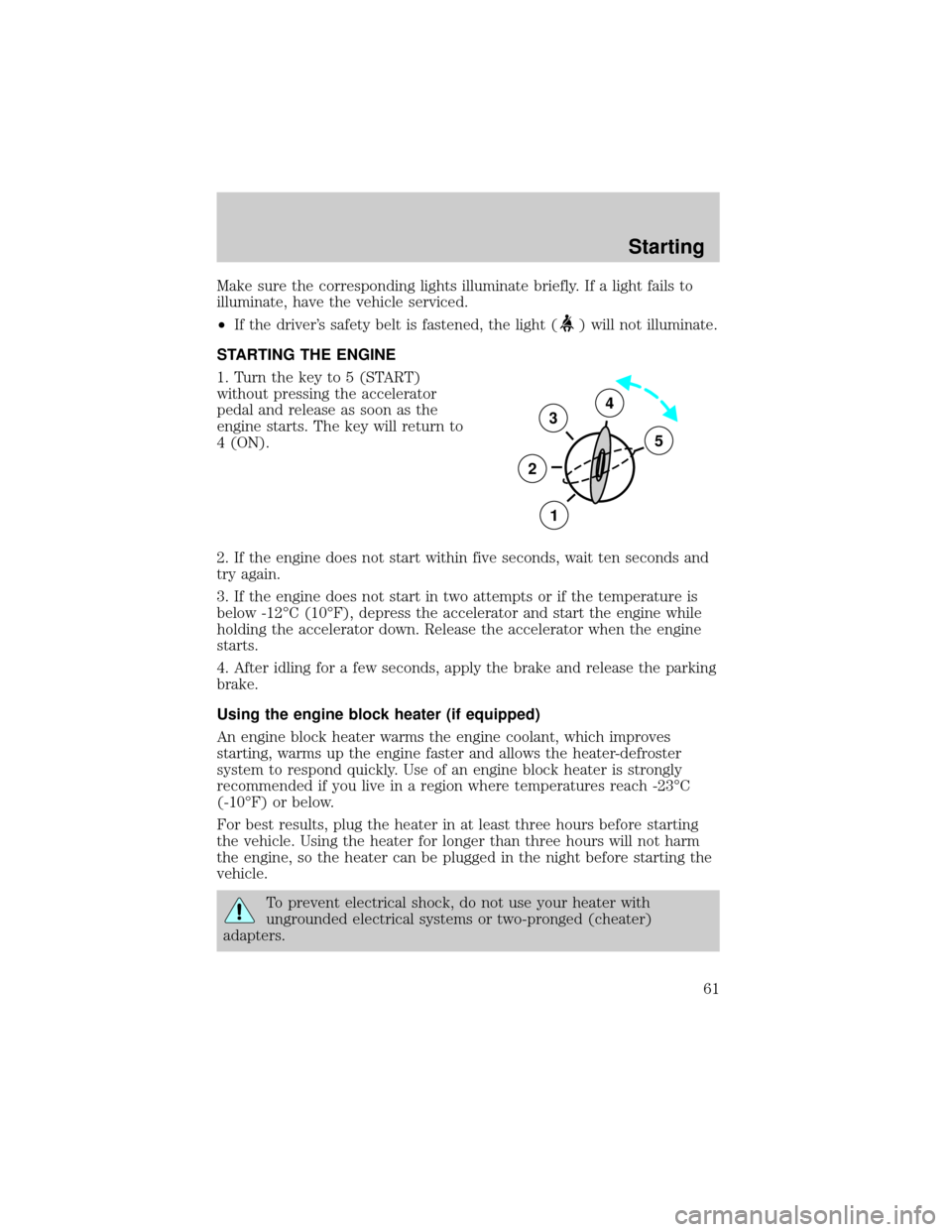
Make sure the corresponding lights illuminate briefly. If a light fails to
illuminate, have the vehicle serviced.
²If the driver's safety belt is fastened, the light (
) will not illuminate.
STARTING THE ENGINE
1. Turn the key to 5 (START)
without pressing the accelerator
pedal and release as soon as the
engine starts. The key will return to
4 (ON).
2. If the engine does not start within five seconds, wait ten seconds and
try again.
3. If the engine does not start in two attempts or if the temperature is
below -12ÉC (10ÉF), depress the accelerator and start the engine while
holding the accelerator down. Release the accelerator when the engine
starts.
4. After idling for a few seconds, apply the brake and release the parking
brake.
Using the engine block heater (if equipped)
An engine block heater warms the engine coolant, which improves
starting, warms up the engine faster and allows the heater-defroster
system to respond quickly. Use of an engine block heater is strongly
recommended if you live in a region where temperatures reach -23ÉC
(-10ÉF) or below.
For best results, plug the heater in at least three hours before starting
the vehicle. Using the heater for longer than three hours will not harm
the engine, so the heater can be plugged in the night before starting the
vehicle.
To prevent electrical shock, do not use your heater with
ungrounded electrical systems or two-pronged (cheater)
adapters.
3
2
1
5
4
Starting
61
Page 62 of 144
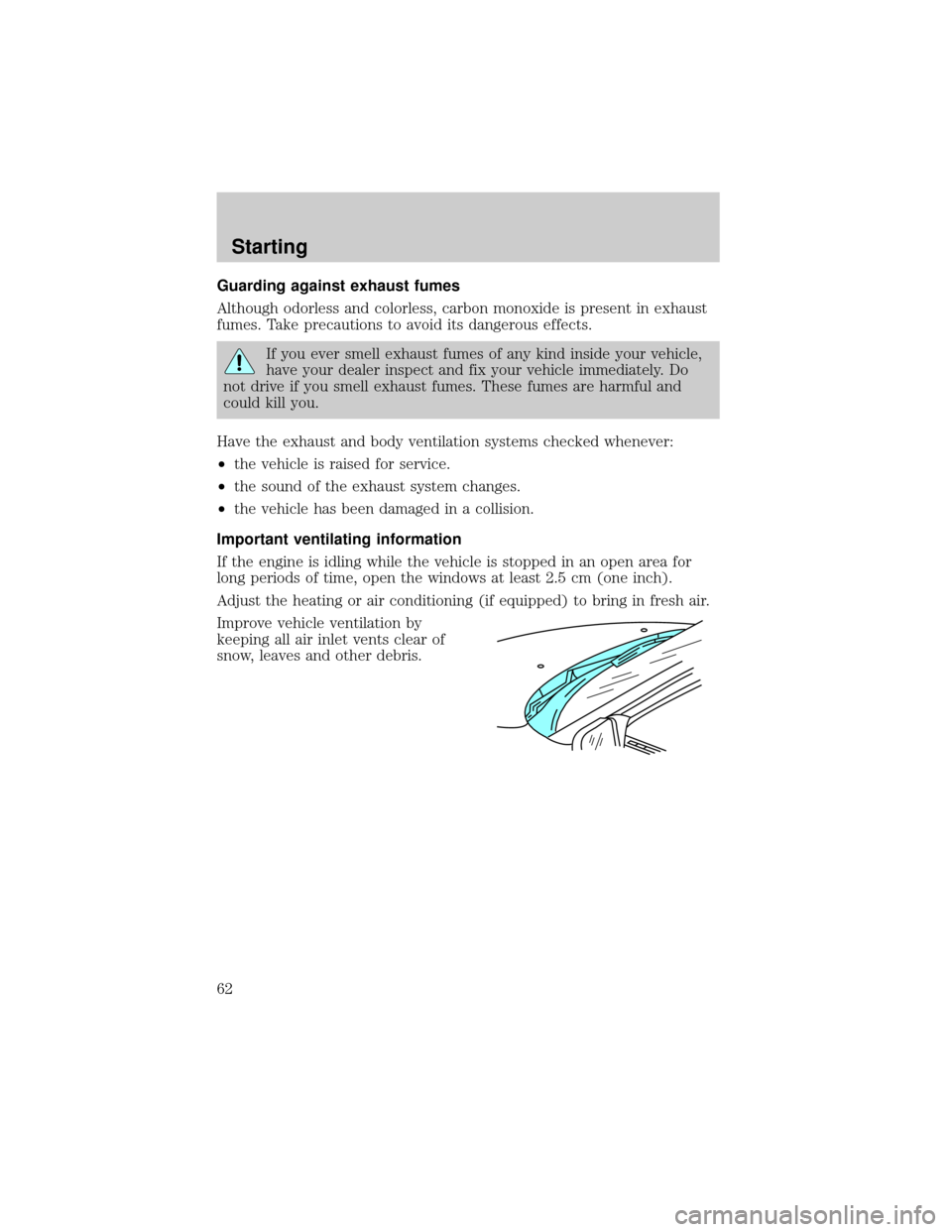
Guarding against exhaust fumes
Although odorless and colorless, carbon monoxide is present in exhaust
fumes. Take precautions to avoid its dangerous effects.
If you ever smell exhaust fumes of any kind inside your vehicle,
have your dealer inspect and fix your vehicle immediately. Do
not drive if you smell exhaust fumes. These fumes are harmful and
could kill you.
Have the exhaust and body ventilation systems checked whenever:
²the vehicle is raised for service.
²the sound of the exhaust system changes.
²the vehicle has been damaged in a collision.
Important ventilating information
If the engine is idling while the vehicle is stopped in an open area for
long periods of time, open the windows at least 2.5 cm (one inch).
Adjust the heating or air conditioning (if equipped) to bring in fresh air.
Improve vehicle ventilation by
keeping all air inlet vents clear of
snow, leaves and other debris.
Starting
62
Page 66 of 144
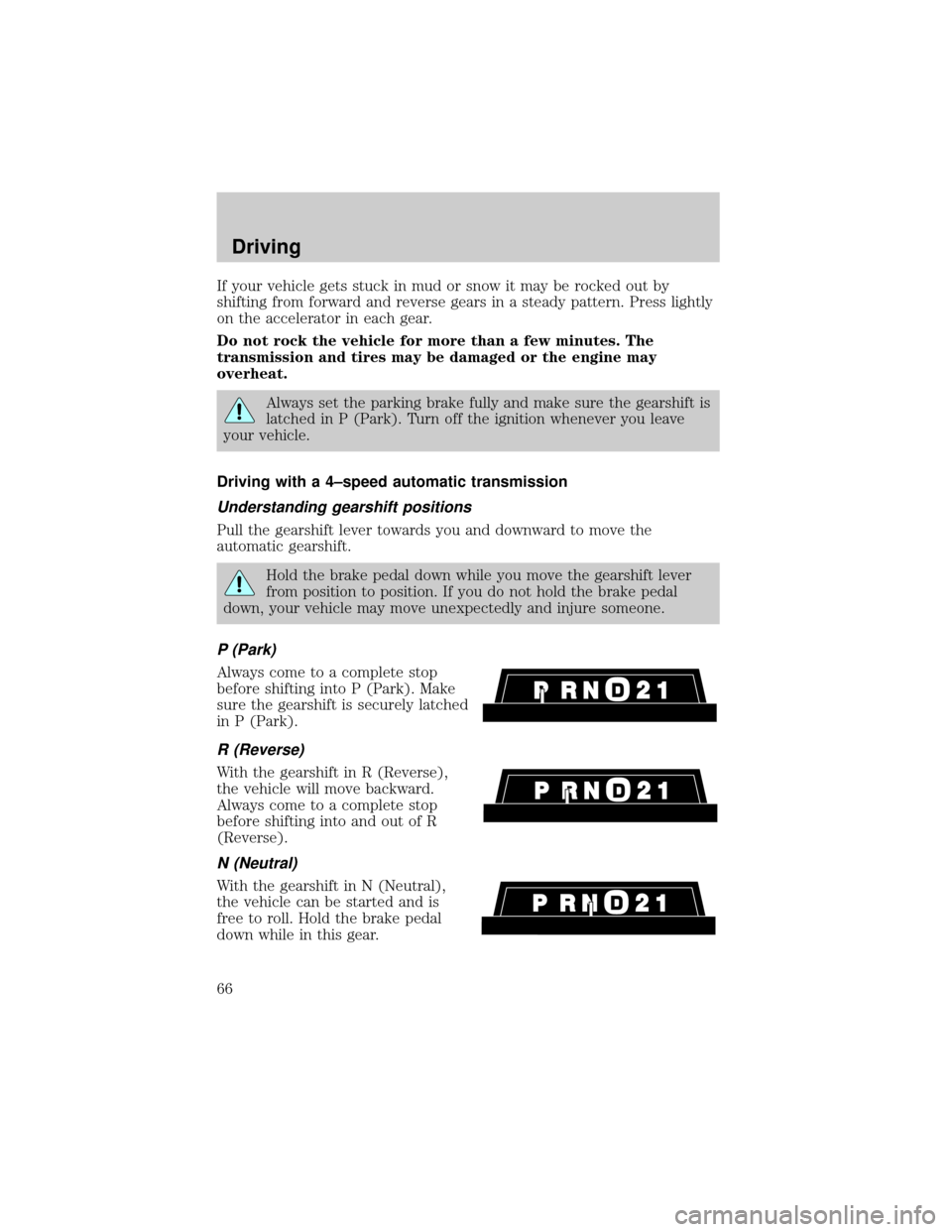
If your vehicle gets stuck in mud or snow it may be rocked out by
shifting from forward and reverse gears in a steady pattern. Press lightly
on the accelerator in each gear.
Do not rock the vehicle for more than a few minutes. The
transmission and tires may be damaged or the engine may
overheat.
Always set the parking brake fully and make sure the gearshift is
latched in P (Park). Turn off the ignition whenever you leave
your vehicle.
Driving with a 4±speed automatic transmission
Understanding gearshift positions
Pull the gearshift lever towards you and downward to move the
automatic gearshift.
Hold the brake pedal down while you move the gearshift lever
from position to position. If you do not hold the brake pedal
down, your vehicle may move unexpectedly and injure someone.
P (Park)
Always come to a complete stop
before shifting into P (Park). Make
sure the gearshift is securely latched
in P (Park).
R (Reverse)
With the gearshift in R (Reverse),
the vehicle will move backward.
Always come to a complete stop
before shifting into and out of R
(Reverse).
N (Neutral)
With the gearshift in N (Neutral),
the vehicle can be started and is
free to roll. Hold the brake pedal
down while in this gear.
Driving
66
Page 67 of 144
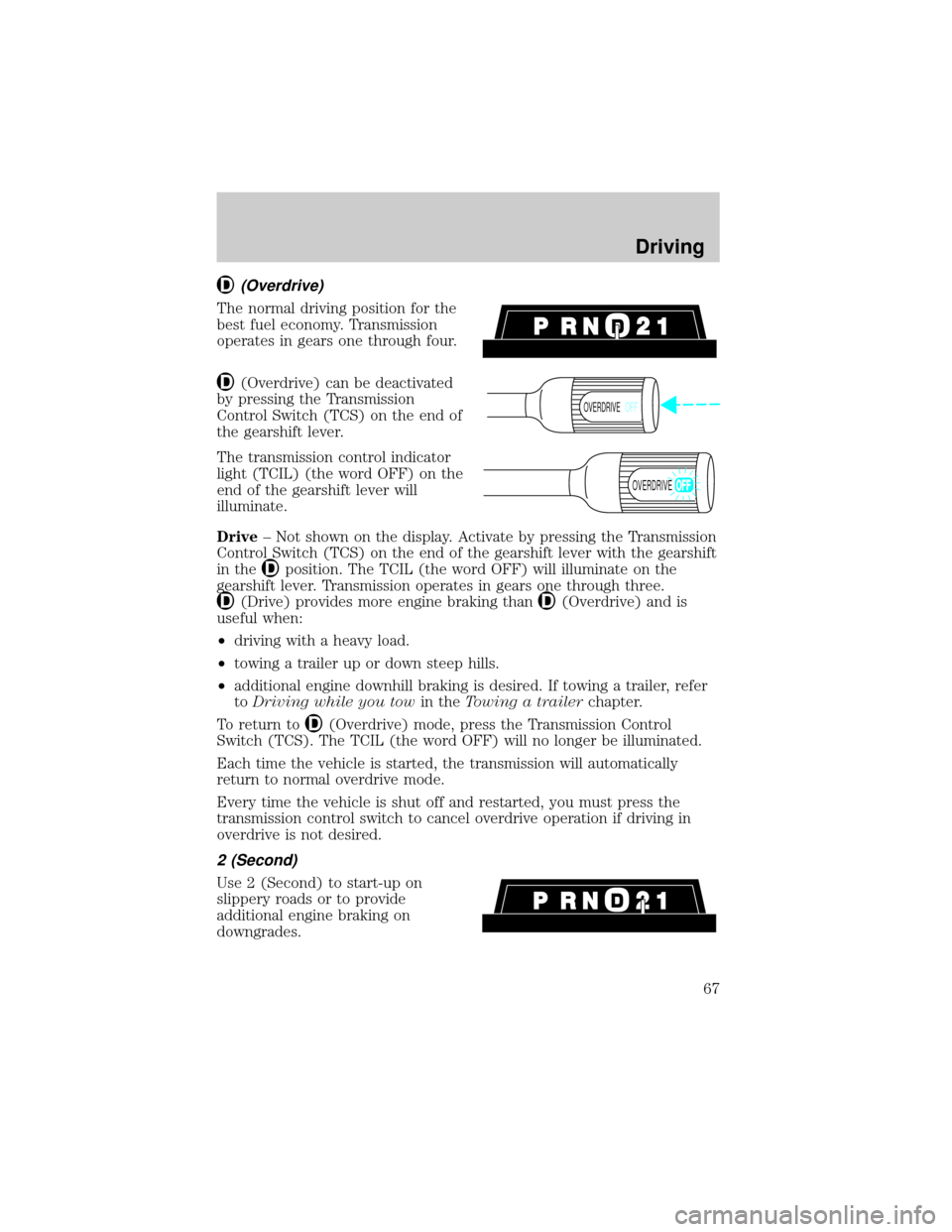
(Overdrive)
The normal driving position for the
best fuel economy. Transmission
operates in gears one through four.
(Overdrive) can be deactivated
by pressing the Transmission
Control Switch (TCS) on the end of
the gearshift lever.
The transmission control indicator
light (TCIL) (the word OFF) on the
end of the gearshift lever will
illuminate.
Drive± Not shown on the display. Activate by pressing the Transmission
Control Switch (TCS) on the end of the gearshift lever with the gearshift
in the
position. The TCIL (the word OFF) will illuminate on the
gearshift lever. Transmission operates in gears one through three.
(Drive) provides more engine braking than(Overdrive) and is
useful when:
²driving with a heavy load.
²towing a trailer up or down steep hills.
²additional engine downhill braking is desired. If towing a trailer, refer
toDriving while you towin theTowing a trailerchapter.
To return to
(Overdrive) mode, press the Transmission Control
Switch (TCS). The TCIL (the word OFF) will no longer be illuminated.
Each time the vehicle is started, the transmission will automatically
return to normal overdrive mode.
Every time the vehicle is shut off and restarted, you must press the
transmission control switch to cancel overdrive operation if driving in
overdrive is not desired.
2 (Second)
Use 2 (Second) to start-up on
slippery roads or to provide
additional engine braking on
downgrades.
OVERDRIVEOFF
OVERDRIVE
Driving
67
Page 68 of 144
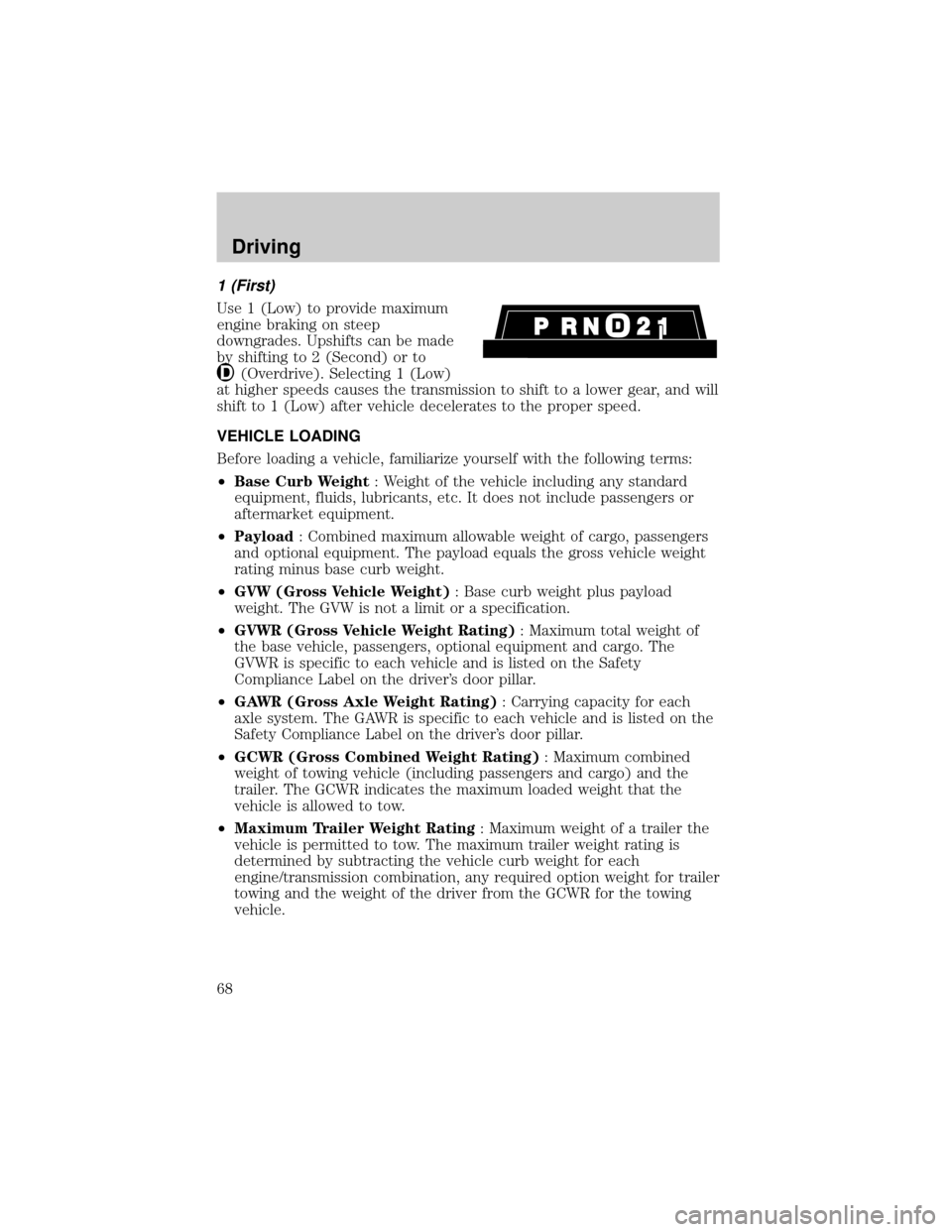
1 (First)
Use 1 (Low) to provide maximum
engine braking on steep
downgrades. Upshifts can be made
by shifting to 2 (Second) or to
(Overdrive). Selecting 1 (Low)
at higher speeds causes the transmission to shift to a lower gear, and will
shift to 1 (Low) after vehicle decelerates to the proper speed.
VEHICLE LOADING
Before loading a vehicle, familiarize yourself with the following terms:
²Base Curb Weight: Weight of the vehicle including any standard
equipment, fluids, lubricants, etc. It does not include passengers or
aftermarket equipment.
²Payload: Combined maximum allowable weight of cargo, passengers
and optional equipment. The payload equals the gross vehicle weight
rating minus base curb weight.
²GVW (Gross Vehicle Weight): Base curb weight plus payload
weight. The GVW is not a limit or a specification.
²GVWR (Gross Vehicle Weight Rating): Maximum total weight of
the base vehicle, passengers, optional equipment and cargo. The
GVWR is specific to each vehicle and is listed on the Safety
Compliance Label on the driver's door pillar.
²GAWR (Gross Axle Weight Rating): Carrying capacity for each
axle system. The GAWR is specific to each vehicle and is listed on the
Safety Compliance Label on the driver's door pillar.
²GCWR (Gross Combined Weight Rating): Maximum combined
weight of towing vehicle (including passengers and cargo) and the
trailer. The GCWR indicates the maximum loaded weight that the
vehicle is allowed to tow.
²Maximum Trailer Weight Rating: Maximum weight of a trailer the
vehicle is permitted to tow. The maximum trailer weight rating is
determined by subtracting the vehicle curb weight for each
engine/transmission combination, any required option weight for trailer
towing and the weight of the driver from the GCWR for the towing
vehicle.
Driving
68
Page 69 of 144
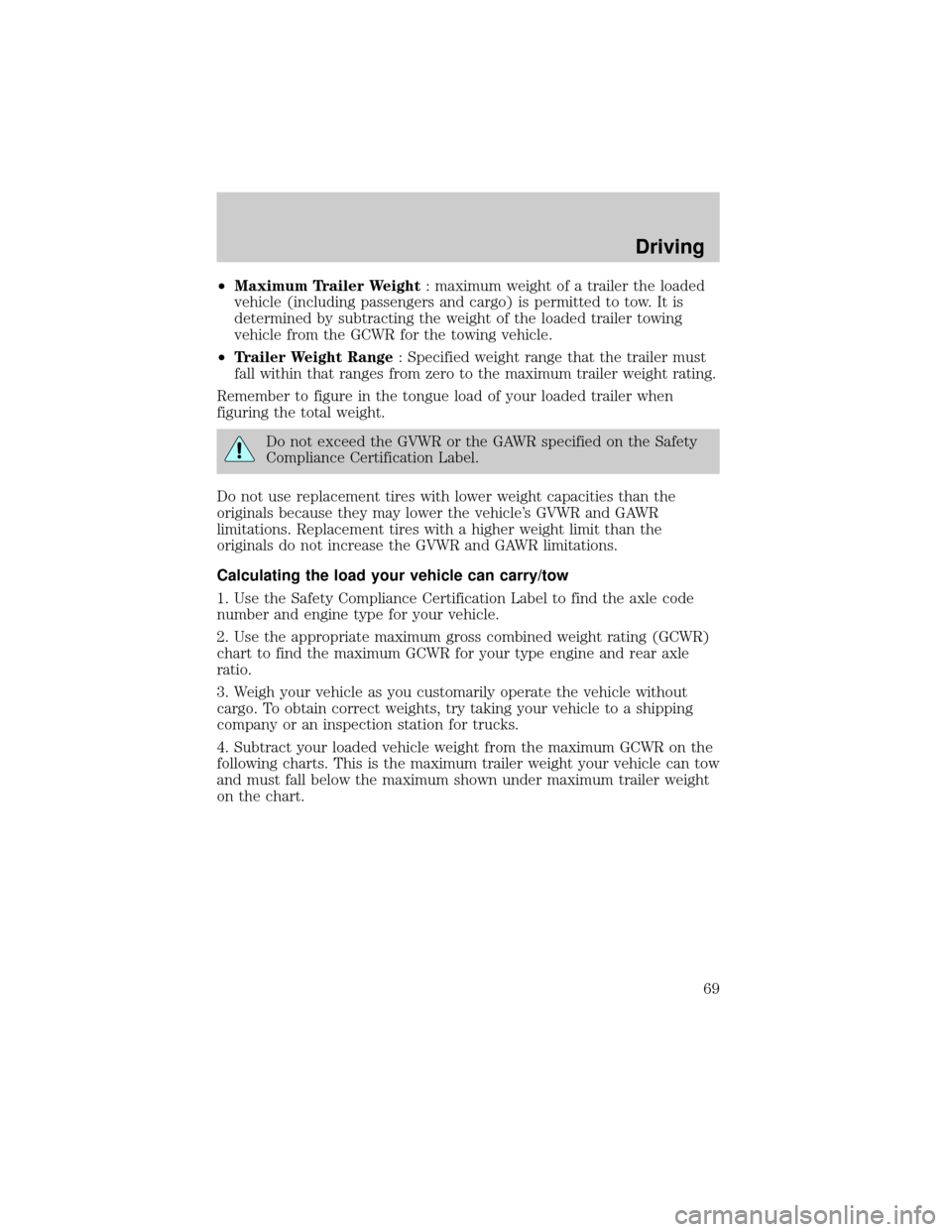
²Maximum Trailer Weight: maximum weight of a trailer the loaded
vehicle (including passengers and cargo) is permitted to tow. It is
determined by subtracting the weight of the loaded trailer towing
vehicle from the GCWR for the towing vehicle.
²Trailer Weight Range: Specified weight range that the trailer must
fall within that ranges from zero to the maximum trailer weight rating.
Remember to figure in the tongue load of your loaded trailer when
figuring the total weight.
Do not exceed the GVWR or the GAWR specified on the Safety
Compliance Certification Label.
Do not use replacement tires with lower weight capacities than the
originals because they may lower the vehicle's GVWR and GAWR
limitations. Replacement tires with a higher weight limit than the
originals do not increase the GVWR and GAWR limitations.
Calculating the load your vehicle can carry/tow
1. Use the Safety Compliance Certification Label to find the axle code
number and engine type for your vehicle.
2. Use the appropriate maximum gross combined weight rating (GCWR)
chart to find the maximum GCWR for your type engine and rear axle
ratio.
3. Weigh your vehicle as you customarily operate the vehicle without
cargo. To obtain correct weights, try taking your vehicle to a shipping
company or an inspection station for trucks.
4. Subtract your loaded vehicle weight from the maximum GCWR on the
following charts. This is the maximum trailer weight your vehicle can tow
and must fall below the maximum shown under maximum trailer weight
on the chart.
Driving
69
Page 70 of 144

DRIVING THROUGH WATER
Do not drive quickly through standing water, especially if the depth is
unknown. Traction or brake capability may be limited and if the ignition
system gets wet, your engine may stall. Water may also enter your
engine's air intake and severely damage your engine.
If driving through deep or standing water is unavoidable, proceed very
slowly. Never drive through water that is higher than the bottom of the
hubs (truck)/wheel rims (car).
Once through the water, always try the brakes. Wet brakes do not stop
the vehicle as effectively as dry brakes. Drying can be improved by
moving your vehicle slowly while applying light pressure on the brake
pedal.
TRAILER TOWING
Your vehicle may tow a class I, II or III trailer provided the maximum
trailer weight is less than or equal to the maximum trailer weight listed
for your engine and rear axle ratio on the following charts.
Trailer Towing Table
GCWR (Gross Combined Weight Rating)/Trailer Weights
EngineRear
axle
ratioMaximum
GCWR-kg
(lbs.)Trailer weight
range-kg (lbs.)
(0-Maximum)Maximum
Frontal Area
Of Trailer-m
2
(ft2)
Regular Van E-150
4.2L 3.31 4 082 (9 000) 1 860 (4 100) 5.52 (60)
4.2L 3.55 4 536 (10 000) 2 313 (5 100) 5.52 (60)
4.6L 3.31 4 990 (11 000) 2 766 (6 100) 5.52 (60)
4.6L 3.55 5 216 (11 500) 2 993 (6 600) 5.52 (60)
5.4L 3.55 5 443 (12 000) 3 130 (6 900) 5.52 (60)
Regular Van E-250
4.2L 3.73 4 763 (10 500) 2 359 (5 200) 5.52 (60)
5.4L 3.73 5 897 (13 000) 3 402 (7 500) 5.52 (60)
Regular Van E-250 HD
4.2L 4.09 4 990 (11 000) 2 586 (5 700) 5.52 (60)
5.4L 3.73 5 897 (13 000) 3 402 (7 500) 5.52 (60)
Driving
70
Page 71 of 144

Trailer Towing Table
GCWR (Gross Combined Weight Rating)/Trailer Weights
EngineRear
axle
ratioMaximum
GCWR-kg
(lbs.)Trailer weight
range-kg (lbs.)
(0-Maximum)Maximum
Frontal Area
Of Trailer-m
2
(ft2)
Super Van E-250
4.2L 3.73 4 763 (10 500) 2 313 (5 100) 5.52 (60)
5.4L 3.73 5 897 (13 000) 3 357 (7 400) 5.52 (60)
Super Van E-250 HD
4.2L 4.09 4 990 (11 000) 2 540 (5 600) 5.52 (60)
5.4L 3.73 5 897 (13 000) 3 356 (7 400) 5.52 (60)
Regular Van E-350
5.4L 3.55 5 443 (12 000) 2 948 (6 500) 5.52 (60)
5.4L 4.10 5 897 (13 000) 3 402 (7 500) 5.52 (60)
6.8L 3.73 6 804 (15 000) 4 218 (9 300) 5.52 (60)
6.8L 4.10 8 392 (18 500) 4 536 (10 000) 5.52 (60)
7.3L
(Diesel)3.55 7 258 (16 000) 4 536 (10 000) 5.52 (60)
7.3L
(Diesel)4.10 9 072 (20 000) 4 536 (10 000) 5.52 (60)
Super Van E-350
5.4L 3.55 5 443 (12 000) 2 858 (6 300) 5.52 (60)
5.4L 4.10 5 897 (13 000) 3 311 (7 300) 5.52 (60)
6.8L 3.73 6 804 (15 000) 4 173 (9 200) 5.52 (60)
6.8L 4.10 8 392 (18 500) 4 536 (10 000) 5.52 (60)
7.3L
(Diesel)3.55 7 258 (16 000) 4 445 (9 800) 5.52 (60)
7.3L
(Diesel)4.10 9 072 (20 000) 4 536 (10 000) 5.52 (60)
Club Wagon E-150 (8 passenger)
4.2L 3.31 4 082 (9 000) 1 678 (3 700) 5.52 (60)
4.2L 3.55 4 536 (10 000) 2 132 (4 700) 5.52 (60)
4.6L 3.31 4 990 (11 000) 2 540 (5 600) 5.52 (60)
Driving
71
Page 72 of 144

Trailer Towing Table
GCWR (Gross Combined Weight Rating)/Trailer Weights
EngineRear
axle
ratioMaximum
GCWR-kg
(lbs.)Trailer weight
range-kg (lbs.)
(0-Maximum)Maximum
Frontal Area
Of Trailer-m
2
(ft2)
4.6L 3.55 5 216 (11 500) 2 767 (6 100) 5.52 (60)
5.4L 3.55 5 443 (12 000) 2 948 (6 500) 5.52 (60)
Club Wagon Regular E-350 (12 passenger)
5.4L 3.55 5 443 (12 000) 2 722 (6 000) 5.52 (60)
5.4L 4.10 5 897 (13 000) 3 175 (7 000) 5.52 (60)
6.8L 3.73 6 804 (15 000) 4 037 (8 900) 5.52 (60)
6.8L 4.10 8 392 (18 500) 4 536 (10 000) 5.52 (60)
7.3L
(Diesel)3.55 7 258 (16 000) 4 309 (9 500) 5.52 (60)
7.3L
(Diesel)4.10 9 072 (20 000) 4 536 (10 000) 5.52 (60)
Club Wagon Super E-350 (15 passenger)
5.4L 3.55 5 443 (12 000) 2 586 (5 700) 5.52 (60)
5.4L 4.10 5 897 (13 000) 3 039 (6 700) 5.52 (60)
6.8L 3.73 6 804 (15 000) 3 901 (8 600) 5.52 (60)
6.8L 4.10 8 392 (18 500) 4 536 (10 000) 5.52 (60)
7.3L
(Diesel)3.55 7 258 (16 000) 4 173 (9 200) 5.52 (60)
7.3L
(Diesel)4.10 9 072 (20 000) 4 536 (10 000) 5.52 (60)
E-350 RV Cutaway (single rear wheel)
7.3L
(Diesel)4.10 9 072 (20 000) 4 717 (10 400)* 5.52 (60)
E-350 RV Cutaway (dual rear wheel)
5.4L 4.10 5 897 (13 000) 1 134 (2 500) 5.52 (60)
6.8L 4.10 8 392 (18 500) 3 629 (8 000) 5.52 (60)
7.3L
(Diesel)4.10 9 072 (20 000) 4 309 (9 500) 5.52 (60)
Driving
72
Page 73 of 144

Trailer Towing Table
GCWR (Gross Combined Weight Rating)/Trailer Weights
EngineRear
axle
ratioMaximum
GCWR-kg
(lbs.)Trailer weight
range-kg (lbs.)
(0-Maximum)Maximum
Frontal Area
Of Trailer-m
2
(ft2)
E-350 Commercial Cutaway (single rear wheel)
7.3L
(Diesel)4.10 9 072 (20 000) 4 717 (10 400)* 5.52 (60)
E-350 Commercial Cutaway (dual rear wheel)
5.4L 4.10 5 897 (13 000) 1 225 (2 700) 5.52 (60)
6.8L 4.10 8 392 (18 500) 3 720 (8 200) 5.52 (60)
7.3L
(Diesel)4.10 9 072 (20 000) 4 400 (9 700) 5.52 (60)
E-Super Duty
6.8L 4.63 9 072 (20 000) 4 536 (10 000) 5.52 (60)
7.3L
(Diesel)4.63 9 072 (20 000) 4 536 (10 000) 5.52 (60)
E-250/350 Stripped Chassis (single rear wheel)
4.2L 4.09 4 990 (11 000) 1 090 (2 400) 5.52 (60)
5.4L 4.10 5 897 (13 000) 1 542 (3 400) 5.52 (60)
6.8L 3.73 6 804 (15 000) 2 540 (5 600) 5.52 (60)
E-250/350 Stripped Chassis (dual rear wheel)
5.4L 4.10 5 897 (13 000) 1 361 (3 000) 5.52 (60)
6.8L 4.10 8 392 (18 500) 3 856 (8 500) 5.52 (60)
Maximum loaded trailer weight of 4 717 kg (10 400 lbs.) on 7.3L E350
RV and commercial cutaways (single rear wheel) applicable to fifth
wheel trailer usage only. Otherwise, maximum trailer weight is 4 536 kg
(10 000 lbs.).
For high altitude operation reduce GCWR by 2% per 300 meters
(1 000 ft) elevation.
To determine the maximum trailer weight designed for you particular
vehicle as equipped, follow the sectionCalculating the load your
vehicle can tow/carryearlier in this chapter.
Driving
73